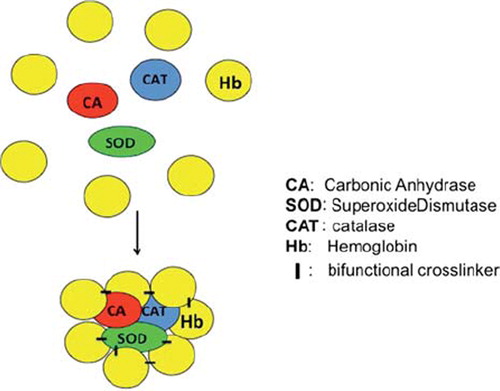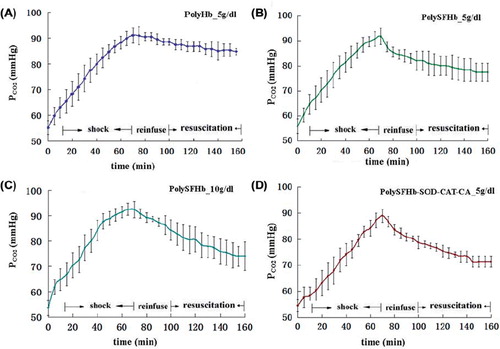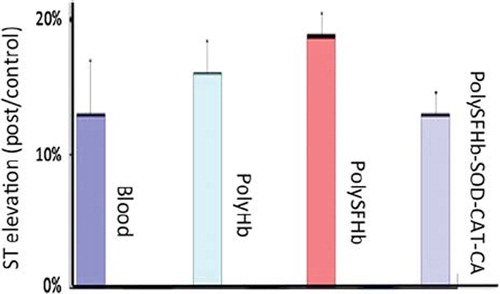Figures & data
Figure 1. Upper: Free molecules of hemoglobin, superoxide dismutase, catalase and carbonic anhydrase in solution. Lower: Glutaraldehyde is used to crosslink the free molecules into a soluble nanobiotechnological complex of Polyhemoglobin-Superoxide dismutase-catalase-carbonic anhydrase.

Figure 2. Tissue PCO2 in hemorrhagic shock (rats). Three time periods: (1). Hemorrhagic shock by removing 67% of total blood volume and maintaining the MAP at 30 mm Hg for 1 hour. (2) Reinfusion of one of the resuscitation fluids. (3) Followed for 1 hour after reinfusion. Resuscitation fluids are (A) Shed blood; (B) Ringer's lactated solution 3 volumes of shed blood; (C) Polyhemoglobin (PolyHb) prepared with pure Hb containing no RBC enzymes and given at the concentration of Hb 10 g/dl, same volume as shed blood; (D) PolySFHb-SOD-CAT-CA prepared from RBC content (SFHb) enriched with additional superoxide dismutase (SOD), catalase (CA) and carbonic anhydrase (CA) given at the concentration of Hb10 g/dl in the same volume as shed blood.

Figure 3. Tissue PCO2 in hemorrhagic shock (rats). As above but with the following resuscitation fluids given in the same volume as shed blood. (A) PolyHb with no RBC enzymes as above but at a lower concentration of Hb 5 g/dl; (B) PolySFHb prepared from RBC content (SFHb) with RBC enzymes at the concentration of Hb 5 g/dl; (C) PolySFHb prepared with SFHb as B above but at a higher concentration of Hb10 g/dl; (D) PolySFHb-SOD-CAT-CA prepared with SFHb but with further enrichment of additional SOD, CAT and CA given at the concentration of Hb 5 g/dl.

Figure 4. This figure compares the effects on tissue PCO2 of all the groups. As shown in graph: Ringer's Lactated solution, PolyHb (10 g/dl), PolySFHb 10 g/dl, Blood 15 g/dl and PolySFHb-SOD-CAT-CA 10 g/dl). Those solutions with hemoglobin concentration of 5 g/dl are: 2 (PolyHb), 4(PolySfHb), 6(PolySFHb-SOD-CAT-CA).

Table I. Hb concentration, molecular weight and enzyme activity/gm Hb.
Table II. Total Hemoglobin and enzymes in each 100 ml of solution.
Figure 5. MAP in hemorrhagic shock (rats). Three time periods: (1). Hemorrhagic shock by removing 67% of total blood volume and maintaining the MAP at 30 mm Hg for 1 hour. (2) Reinfusion of one of the resuscitation fluids. (3) Followed for 1 hour after reinfusion. Resuscitation fluids are (A) Shed blood; (B) Ringer's lactated solution 3 volumes of shed blood; (C) Polyhemoglobin (PolyHb) prepared with pure Hb containing no RBC enzymes and given at the concentration of Hb 10 g/dl, same volume as shed blood; (D) PolySFHb-SOD-CAT-CA prepared from RBC content (SFHb) enriched with additional superoxide dismutase (SOD), catalase (CA) and carbonic anhydrase (CA) given at the concentration of Hb 10 g/dl in the same volume as shed blood.

Figure 6. MAP in hemorrhagic shock (rats). As in but with the following resuscitation fluids given in the same volume as shed blood.(A) PolyHb with no RBC enzymes as above but at a lower concentration of Hb 5 g/dl; (B) PolySFHb prepared from RBC content (SFHb) with RBC enzymes at the concentration of Hb 5 g/dl; (C) PolySFHb prepared with SFHb as B above but at a higher concentration of Hb10 g/dl; (D) PolySFHb-SOD-CAT-CA prepared with SFHb but with further enrichment of additional SOD, CAT and CA given at the concentration of Hb 5 g/dl.

Figure 7. This is a combined figure to compare the effects on MAP of all the groups. As shown in graph: Ringer's Lactated solution, PolyHb (10 g/dl), PolySFHb 10 g/dl, Blood 15 g/dl and PolySFHb-SOD-CAT-CA 10 g/dl). Those solutions with hemoglobin concentration of 5 g/dl are: 2 (PolyHb), 4(PolySfHb), 6(PolySFHb-SOD-CAT-CA).

